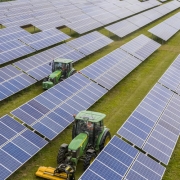Solar accounted for 40% of all new electric generating capacity in the U.S. in 2019, report finds
According to the U.S. Solar Market Insight 2019 Year-in-Review report, released by the Solar Energy Industries Association (SEIA) and Wood Mackenzie, solar accounted for 40% of all new electric generating capacity in the U.S. in 2019, its highest share ever and more than any other source of electricity, with 13.3 gigawatts (GW) installed.
Despite policy challenges and a second year of the Section 201 tariffs, the U.S. solar market grew by 23% from 2018.
According to the report, total installed PV capacity in the U.S. was projected to rise by 47% in 2020, with nearly 20 GW of new installations expected by the end of the year. Each of the next two years were expected to be the largest on record for the U.S. solar industry.
The residential solar sector saw record-setting installation totals with more than 2.8 GW installed, led by a record year in California and continued growth in emerging markets. The segment saw annual growth of 15% while achieving its highest installation volumes in history.
But emerging markets also deserve credit for this year’s record-breaking installations as Florida installed the second most rooftop solar in the country after California.
Meanwhile, the utility-scale market added 8.4 GW of new capacity in 2019, more than half of which came online in the fourth quarter. The 4.4 GW of utility PV installed in the fourth quarter makes it the second-largest quarter in history for the market. A total of 30.4 GW of new utility PV projects were announced in 2019, bringing the contracted pipeline to a record high of 48.1 GW.
In 2019, non-residential PV saw an annual decline of 7%, due largely to policy reforms and interconnection delays in key states like California and Massachusetts. A shrinking pipeline of community solar projects in Minnesota also contributed to deployment declines, while community solar markets in New York, Maryland, Illinois and New Jersey are expected to grow going forward.
The emergence of Texas and Florida as top solar states, along with strong year in established markets like Arizona, Georgia and North Carolina, helped drive solid growth in 2019 across all segments.
Over the next five years, total installed U.S. PV capacity was expected to more than double, with annual installations projected to reach 20.4 GW in 2021 prior to the expiration of the federal solar Investment Tax Credit for residential systems and a drop to 10% for commercial and utility-scale customers.
Key findings from the report include:
- Solar accounted for 40% of all new electricity generating capacity added in the U.S. in 2019.
- In 2019, the U.S. solar market installed 13.3 GW of solar PV, a 23% increase from 2018.
- Cumulative operating PV capacity in the U.S. now exceeds 76 GW, up from just 1 GW at the end of 2009.
- The U.S. saw record-setting residential solar capacity added in 2019 with more than 2.8 GW installed.
- The contracted utility PV pipeline grew to a record high of 48.1 GW in 2019.
- Community solar continues to expand its geographic diversification, with the sub-segment seeing its third consecutive year of more than 500 MW installed.
Source: Press Release by Solar Energy Industries Association (SEIA). Photo credit: U.S. Department of Energy via Flickr (U.S. Government Works).











